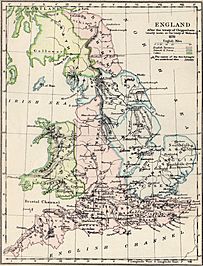Treaty of Alfred and Guthrum facts for kids
The Treaty of Alfred and Guthrum was an important peace agreement made in the 800s. It was signed between King Alfred of Wessex and Guthrum, a powerful Viking leader who ruled East Anglia. This treaty set clear borders between their lands. It also included rules for peaceful trading and even set a value for people's lives, called weregild, to prevent arguments.
How the Treaty Came About
In 866, a large Viking army, known as the Great Heathen Army, arrived in East Anglia. Their goal was to conquer all the English kingdoms. They managed to take over East Anglia, Mercia, and Northumbria. They also tried to conquer the Kingdom of Wessex.
However, in 878, King Guthrum and his Danish army were defeated by King Alfred's army at the Battle of Edington. After this big loss, Guthrum had to agree to Alfred's terms. As part of their surrender, Guthrum was baptised (became a Christian). This helped him rule his Christian subjects more easily, even though he still kept his pagan beliefs for his Viking followers. After this, Guthrum and his army had to leave Wessex. This first agreement was called the Treaty of Wedmore.
Sometime after the Treaty of Wedmore, Alfred and Guthrum made another, more detailed agreement. This new treaty was meant to create lasting peace between their kingdoms. It is now known as the Treaty of Alfred and Guthrum. This treaty is one of the few original documents from King Alfred's time that we still have today. It exists in Old English and also in a Latin collection called Quadripartitus.
Historians are not sure exactly when this treaty was made. They believe it was signed sometime between 878 and 890, the year Guthrum died.
The treaty started by confirming that both Alfred and Guthrum had the right to rule their lands. Guthrum's land was in East Anglia, and Alfred's was in Mercia. The treaty also set rules for "blood money" or weregild. This was a payment made to the family of someone who was killed. The amount depended on the person's social status. Other parts of the treaty covered buying and selling people, horses, and oxen. It also included rules for giving hostages to make sure everyone kept their promises during trade.
What the Treaty Said
There are a few different copies of this treaty. The first ones were written in Old English. Here are the main points of the treaty, explained in simpler terms:
- Introduction: King Alfred, King Guthrum, and their advisors, along with all the people of England and East Anglia, agreed to these peace terms. They promised to follow these rules for themselves and for future generations.
- 1. Borders: The treaty clearly marked the boundary between their lands. It started along the River Thames, then went up the River Lea to its source. From there, it went in a straight line to Bedford, and then up the River Ouse to a famous old road called Watling Street.
- 2. Value of Life (Weregild): If someone was killed, whether they were English or Danish, their life had the same value. For most people, this was 8 half-marks of pure gold. For common farmers or freed Danish people, the value was 200 shillings. This payment was meant to prevent revenge and keep the peace.
- 3. Accusations and Justice: If someone accused a king's thegn (a high-ranking noble or warrior) of murder, that thegn could prove his innocence by getting twelve other king's thegns to swear an oath for him. If someone accused a person of lower rank, that person would need eleven people of their own rank and one king's thegn to swear for them. This rule applied to any dispute involving more than 4 mancusses (a type of gold coin). If the accused person could not prove their innocence, they had to pay three times the value of the stolen goods.
- 4. Buying and Selling: Everyone had to know who was selling them slaves, horses, or oxen. This was to make sure the goods were legally owned and not stolen.
- 5. Movement and Trade: The treaty stated that no slaves or free people could go from one side to the other (English to Danish, or Danish to English) without permission. However, if people wanted to trade cattle or goods, they were allowed to do so. But they had to give hostages as a promise that they would behave peacefully and not try to trick anyone.
See also
- Treaty of Wedmore
- List of treaties



